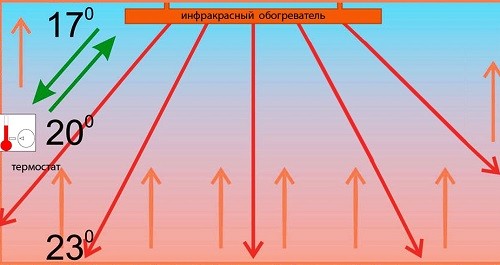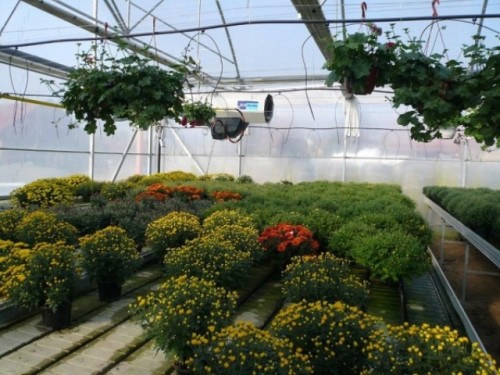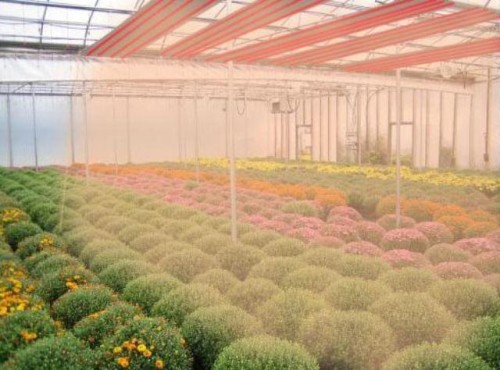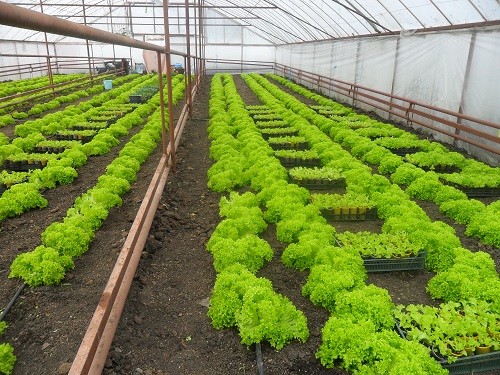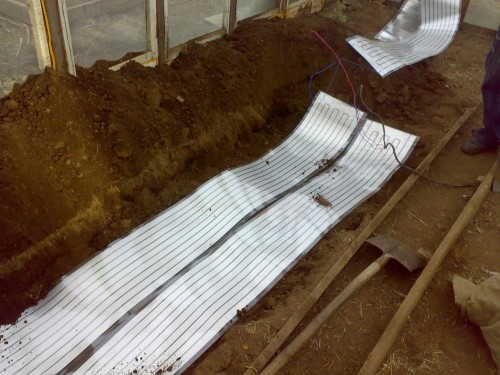
Infrared heaters for greenhouses: characteristics, advantages, choice Climate,Useful advice
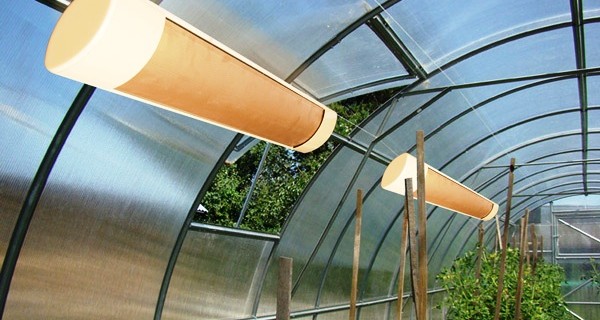
Each experienced gift should be known that heavily in the cultivation of fruit crops plays one of the priority roles. Under favorable conditions, in one season, it is not possible to collect one, but several yields. To ensure a comfortable temperature in Teplitsa, at the cool time of the year, there have always existed their methods. Infrared heaters are a modern solution to this issue. About what characteristics these devices possess, and how to choose an IR Heater for Greenhouses, we will tell in this article.
Content
Principle of operation of IR heaters
The principle of operation of infrared heaters is very similar to the work of the natural light source and heat - the sun. That is why plants develop very quickly and can be fruiting several times per season without aggressive feeding. All items and planes under the influence of radiation absorb infrared rays and return them into space.
Heaters are equipped with a solid metal case, which contains hermetic glass tubes with heating elements. Thus, heat is transferred to a special reflective surface, covered with a thermal film, and dissolved evenly by room.
One of the main reasons for the popularity of IR heaters is that they have the highest efficiency. At the same time, you can manually adjust the heating temperature, which significantly reduces the consumption of electricity. Even if for some reason an unscheduled light shutdown, heat obtained from the heater is enough for another 6-7 hours.
Infrared heaters are distinguished by uninterrupted operation. Even if one of the heating plates fails, the rest will continue to function.
Infrared rays, which are the carrier of the energy of heaters, can be reduced by any material body (alive and non-residential objects, liquids or solid bodies) with a temperature greater than absolute (physical) zero equal to -273c. Rays are essentially electromagnetic waves, as well as light that is visible to the naked eye. The IR ray spectrum is between the red spectrum and short waves.
The length differences three ranges of IR rays:
- Far-ray length from 3 microns to 50 microns.
- The average is the length of the beam from 1.4 μm to 3 microns.
- Middle - ray length from 0.74 μm to 1 microns.
Accordingly, the waves are called long, medium or short.
The length of the infrared wave depends on the body temperature, which emits it - the higher the temperature, the shorter the wave and the stronger the radiation intensity. When the body temperature increases, the spectrum of its infrared radiation shifts closer to the light, visible to the naked eye. As a result, the body is first perceived as dark red, then it becomes brighter, yellow and at the end whites from raining to high temperature. To bring a visual example, we propose to remember how the metal is heated from the fire, passing all the above-described "color" stages. Practically the same happens with the incandescent lamp in the heater whose temperature can reach 1000-1300c.
Often you can meet such terms as "light", "dark", "white" heaters. In order not to get confused in the notation and choose the desired device, remember the principle of operation and the wavelength. Thus, short-wave heaters can also be called "light" or "white". They warm well, but for a short distance. Long-wave, on the contrary, light and heat, but the intensity is much smaller.
How to work IR Heaters in greenhouses
Infrared heaters for greenhouses can be installed on the ceiling so that the directional stream of energy warms the soil and plants. If you do so that the heaters have involved their radiation all the useful area of \u200b\u200bthe greenhouse, you can create a very interesting effect - warm air will not climb cold. As a result, there will be no sharp mixing of two air reservoirs, and slow temperature is favorably affected by the microclimate. Also, due to this effect, it is possible to avoid heat loss through the roof of the greenhouse, since the temperature difference at the ceiling will be insignificant.
Plants under the influence of IR rays feel as comfortable as if they were not born under the affectionate spring sun. Heaters absolutely do not affect air humidity and do not drown it. It is very important to ensure a point, not uniform distribution of heat, since various garden crops require different levels of heating. Infrared heaters, unlike the rest, fully allow to create such conditions. Even in small-sized greenhouses, you can use several temperature modes and completely eliminate heat loss.
Competently installed equipment saves up to 50% of electricity. For this reason, many prefer to buy heaters for greenhouses that pay off their cost in the first season.
Almost all garden crops are poorly perceived by drafts. If you install an IR heater near the input or window (in the most "cold" zones), then you can completely eliminate the movement of cold air streams and compensate for the heat loss.
Many are familiar with the interesting theory of the impact of sounds on the growth of plants. At school, even carry out experiments on the cultivation of beans under classical instrumental music and under modern electronic rock. Differences in growth rates and yields are simply fantastic - the beans that grew up under the accompaniment of Baha or Mozart is distinguished by a fortress and a good harvest, while the rest of the plants ride weak and give a small amount of fruits. That is why good gardeners are watching not only that their plants are warm, but also behind the sounds that surround them. Infrared heaters are completely silent, so they do not affect plants in this regard.
Another important factor is the absolute non-toxicity of devices - they are safe for plants, and for humans. The cure does not affect the taste of berries and vegetables, while maintaining the optimal amount of vitamins and useful trace elements in their composition. The crop, grown under the heater, not distinguish from what matured in natural conditions. The only difference is that he is spending several times faster.
The durability of the instruments also can not but rejoice - they are capable of uninterrupted to last up to 30 years. Even the highest price of heaters for greenhouses with infrared radiation will pay off for such a long time.
Advantages of IR Heaters
Of the above information, it was already possible to understand that IR heaters are the key to the success of any gardener. But to clearly arrange priorities, consider the advantages of these devices in more detail.
The advantages of IR models compared to other heating methods of greenhouses:
- electromagnetic energy is transmitted point (directionally) directly by plants, and not dissipates in the space without any use;
- undoubted efficiency - on the heating of air takes only 7-10% of the energy of the device. To dig a room with an area of \u200b\u200b10 square meters. m, a sufficient heater with a capacity of only 500 W, and if there is a thermostat - 170 W;
- the device is environmentally friendly;
- natural heating of plants, fully imitating the effect of the Sun;
- fast crop maturation (for the season of plants can be fruiting several times);
- in order to establish an IR heater, you do not need an agreement of power supplying enterprises - it is enough to connect them to the network;
- simplicity and ease of use;
- mobility, small dimensions;
- the ability to regulate heat generation;
- if you install the controller, you can fully automate the heating;
- the cost of heaters will pay off in the first year.
How to choose an IR Heat Heater
Of course, it should be borne in mind that positive feedback from IR heaters were obtained from people who were able to correctly choose the device for their greenhouses and set it properly. The maximum positive effect of the device's operation depends on the exact calculation of heating systems, connections and location.
So, to explain everything simply and quickly, consider the calculation on the example of a standard greenhouse with dimensions of 6x3 m. For such an area, just two heaters with a capacity of 1.2 kW to 1.5 kW. But it is important to take into account not only the power, but also the size of the devices themselves. For example, a device with a length of about 1.8 m with an angle of scattering rays 100-120 degrees is able to heat the zone with dimensions of 2.5x3 m.
Even the coarser calculations will make it clear that two heaters for a greenhouse taken as an example of more than enough. Of course, for more large-scale areas, more heaters or the model is more powerful.
For wide greenhouses there is another option - install heaters not in the center, but on both sides. To do this, you will need about 4 instruments, and their power should be reduced accordingly by 2 times. So you can be absolutely sure that each square centimeter of space falls under the warm effects of the rays.
Types of heaters
There are several types of IR for greenhouses. Above the varieties and length of radiation were described above, now the difference is in the installation method.
Types of installation devices:
- ceiling - optimal location in meter from the surface of the Earth. Best suited for greenhouses with elevated levels of humidity, creating an additional greenhouse effect;
- soil - put directly to the Earth;
- wall;
- infrared films - can be installed on the ground vertically or horizontally. The vertical installation is carried out between the beds when the film envelopes the entire perimeter. With a horizontal installation, the film is bought into the ground to a depth of about 50 cm under the garden. This method is more suitable for a stationary greenhouse when it is not necessary to regularly retrace the beds.
Installation of heaters
For that many modern gardeners love IR heaters, so this is for their mobility and ease of installation. They can easily be installed independently without having an appropriate experience. But for the successful outcome of the event, we recommend to get acquainted with the tips on installing equipment for different premises.
How to install the heater:
- To exclude heat loss, put the device in the "Cold Zone", for example, near the input or window.
- If you purchased a powerful model, then for its effective work and for safety, the installation should be carried out in 1-1.5 m from plants, also in places of reduced temperature.
- Ceiling models should be put every 3 m. The higher the heater is installed, the greater area it covers and the weaker the intensity of its radiation.
- If you bought an appliance with a capacity of 250 W, they should be positioned no further than in the meter from each other, otherwise the power will not be enough for efficient operation. The height of the installation should be calculated by an experimental way, raising the heaters as plants grow. Such small models are popular due to their ease and compactness. They can be suspended for the ceiling beam on the usual wire and, if necessary, adjust the height.
- If you need to warm the entire area of \u200b\u200bthe greenhouse, the devices need to be installed in a checker order.
- If you need to focus heating, install the device immediately before the desired area or above it.
- To maintain the required temperature in automatic mode, you can purchase a special thermostat and a system of climatic auto-control for greenhouses. The work circuit is quite simple: temperature sensors for air or land are connected to the controller. They can be taken out of the greenhouse at a distance of up to 100 m, so you can follow the condition of heating even from the house if it is located nearby.
With the advent of infrared heaters, the possibility of winter gardening is incredibly expanded. Now it is not necessary to wait for the spring sun, to start growing vegetables or berries. Heating the greenhouse in the infrared heater allows you to no longer depend on the vagaries of the weather and receive a consistently rich harvest even in the most unsuccessful year for gardening.




